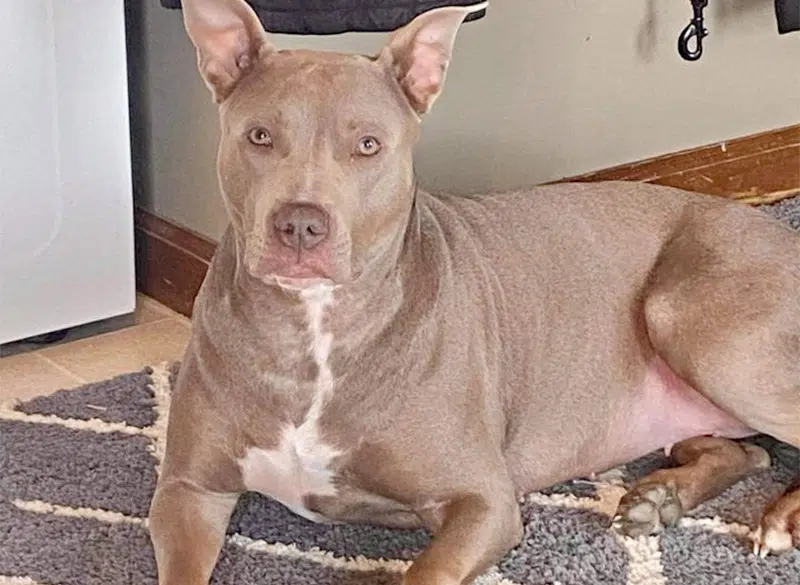The Doberman Pinscher and the American Pitbull Terrier are two dog breeds that many people unduly fear.
Despite this unfair reputation, both of these breeds are sweet at heart and can be exceptionally loyal, loving, and gentle with their owners.
When bred together, they create an incredible hybrid that can make for an incredible companion.
Appearance
A Doberman Pitbull can vary in appearance due to the differences between the parent breeds.
For instance, Pitbulls are usually stocky, muscular, relatively short in stature, and have round eyes and a square snout.
However, Dobermans are taller, have a longer, thinner snout, leaner bodies, and almond-shaped eyes.
Because of these vast differences in appearance, the offspring between the two can vary depending on what genes are most dominant.
Even puppies from the same litter can have different appearances, making it hard to pin down a specific appearance.

That said, Doberman Pitbulls are usually around 50 to 80 pounds, and they have short, sleek fur.
Grooming is very easy, and at most, you will only have to brush them every two to three weeks.
Their fur can range in color from white and grey to brown, bindle, black, and even gold.
All of this depends on the coloration of the parents and who has the dominant genes.
Typically, they tend to be taller than Pitbulls, and they will need to have a good amount of room to move around.
If you’re looking for a small dog, this breed isn’t something to consider.
Temperament
Because the parents of a Doberman Pitbull have such fearsome reputations, many people worry that their mixed offspring will have a bad temperament.
However, the myths about the viciousness of these two parent dogs are false, and any bad behavior can be chalked up to poor training and ownership in most cases.
However, these dogs can be a handful and they are a combination of both speed and strength, which makes them exceptional working dogs.
They do have a prey drive, which means, without training and socialization, they can be prone to trying to chase smaller animals.
You will need to socialize them with people and other animals, and training is a must.
That said, training can be relatively easy if you are firm, as these dogs are highly intelligent and can learn commands well.
They can be stubborn to a point, but with consistent work, they can be trained to become perfect companions.
If done properly, these dogs can have an even temperament and be both affectionate and loyal to their owners.
Even families with children can appreciate these dogs without worrying that they are going to be hyper-aggressive towards everyone.
Another thing to keep in mind is that both parent breeds can have difficulty with separation anxiety, which can be passed on to their offspring.
This means that Doberpits are best suited for homes where they aren’t going to be left alone for long periods of time.
Exercise and Training
Doberpits are agile and energetic and they will require daily exercise to help prevent restlessness.
Two or even three walks every day is best, not including time spent playing in the yard.
If you’re a nature lover, these dogs can be great hiking companions once they are trained and socialized.
They also love jogging, running, biking, and really almost any outdoor activity that you can think of.
Agility courses can be great for Doberpits as they allow them to engage both their bodies and their minds.
Couple this with some fetch, tug-of-war, and keep-away, and you’ll have one happy pup on your hands.
When it comes to training, a Doberpit will require patience, love, firmness, and a lot of energy.
Many owners may also benefit from the guidance of a professional trainer to teach them the best methods for training their Doberpits.
Repetition and consistency are key, and when coupled with positive reinforcement, this can be the best way to instill lasting obedience in them.
Remember to never use force or aggressiveness during training, as this can cause fear and break the trust that your dog has in you.
This can cause them to lash out later on, and with a dog like this, you don’t want to push their limits.
However, when trained properly, the persistence will be worth it as these dogs can make for some of the most loyal and caring companions that you could ask for.
Health Concerns
Although mixed breeds aren’t as prone to as many health concerns as purebred dogs, there are still some to keep in mind.
For instance, some minor conditions include:
- Gastric Torsion
- Hypothyroidism
- Skin Allergies
- Ear Infections
- Osteosarcoma
While some of these can be quite serious, they are considered minor due to them being only a minor risk of occurring.
However, some of the more serious conditions that are more likely to occur include:
- Cardiomyopathy
- Hip Dysplasia
- Aortic Stenosis
With all dogs comes the risk of illness and chronic conditions later in life, and many are unavoidable.
While this breed does have some concerns that you should be aware of, it is by no means a reason to overlook them.
A Great Companion
The Doberpit could make for the perfect companion dog if you are willing to invest in its training, socialization, and exercise requirements.
Although they do take work, they are well worth it as a unique and truly amazing crossbreed.
If you are considering adopting a Doberpit, consider if you have the time and space for their training, as well as their exercise.
Those living in small apartments may not have the resources that this dog needs.
Similarly, if you work long hours and cannot devote a lot of time to them daily, you may want to wait before adopting.
However, if you have the ability and the means, this breed can be a faithful companion that will stick by you for many years to come.
